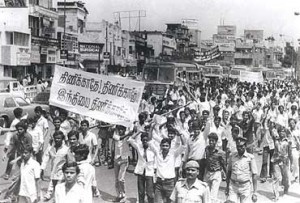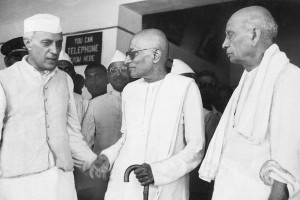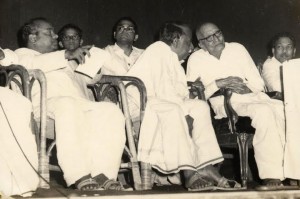Hindi & Other Indian languages (Cont.) Posted by Nitin Kumar on Sep 30, 2010 in Hindi Language
|
Hindi and other Indian languages (continued) Hindi gained enthusiasm in the northern Indian states, because reputed societies for Hindi, Jan Sangh and Samyukta were active in those states. Sangh and Samyukta worked to replace English as India’s official language as soon as possible. English was used as the lingua franca in India and gained importance in press, higher education, law, administration, and modern commercial activities. In the southern part of India, the Dravidian language groups resisted strongly to the spread of Hindi. Most noticeably was the southern regionalist Dravidian Progressive Federation, which was at the forefront of resistance to the spread of Hindi in southern states. This led to the bloody anti-Hindi riot of 1965 in Chennai (previously “Madras”) where the Dravidians were successful in countering the spread of Hindi. In response to the1965 riot, the first Prime minister of India gave personal assurance to non-Hindi speaking regions that Hindi would not be imposed to any non-Hindi states against their will. But for the south- Indian states, this assurance was not enough and they wanted a constitutional amendment confirming that English would be used officially along with Hindi until English speakers were willing to forego its use. On this serious matter, a national meeting with all India’s education ministers was held in the April 1967. They recommended that within five years, the regional languages dissipate the use of English from higher education. Moreover, Hindi and English would be officially used along with the regional language to promote national integration and unity through Hindi, the regional language would be maintained to preserve the culture of the diverse states and they would remain open to world affairs through the use of English. However, the new union education minister, Mr. Trguna Sen questioned this three language formula. His view was that what is good for national integration is not necessarily good for education. On this, many people said that the exclusive use of regional language in higher education would undermine the national integration efforts (Hindi) and it would also hinder India’s ability to communicate on a global scale (English).
These factors affected the spread of Hindi in India while limiting its reach to one of many rather than the sole official language of India. |
हिन्दी और अन्य भारतीय भाषाए (शेष) उत्तर भारतीय राज्यों में हिन्दी का उत्साह अधिक था, वहाँ हिंदी की प्रतिष्ठित संस्था, जनसंघ और सैमयुक्ता समाजवादी पार्टियों सक्रिय थी। वे भारत की आधिकारिक भाषा अंग्रेजी, जो अब तक देश भर में प्रेस, उच्च शिक्षा, कानून, प्रशासन और आधुनिक व्यावसायिक गतिविधियों के लिए इस्तेमाल की जा रही थी, को जल्द से जल्द हिंदी भाषा में बदलने के लिए उत्सुक थे। भारत के दक्षिणी भाग में, जहाँ द्रविड़ भाषा समूह अपनी क्षेत्रीय भाषाओं को बढ़ावा देने के लिए दृढ़ था। उन में सबसे आगे, दक्षिणी क्षेत्रीय द्रविड़ प्रगतिशील फेडरेशन थी। जो दक्षिणी राज्यों में हिंदी के प्रसार के विपक्ष में प्रयासरत थी। सन 1965 के चेन्नई (पहले “मद्रास”) में हुए हिन्दी विरोधी दंगों को उनकी जीत के रूप में देखा गया। इस पर भारत के प्रथम प्रधानमंत्री, श्री जवाहर लाल नेहरु ने गैर-हिन्दी भाषी राज्यों को व्यक्तिगत आश्वासन दिया कि सरकार किसी भी गैर-हिंदी राज्यों को हिन्दी स्वीकार करने के लिए मजबूर नहीं करगी और वह खुद तय कर सकते है की, वह कब इसे स्वीकार करना चाहते हैं. लेकिन दक्षिण भारतीय राज्यों के लिए यह व्यक्तिगत आश्वासन पर्याप्त नहीं था. वह इस आश्वासन के अलावा एक संवैधानिक संशोधन कराना चाहते थे कि आधिकारिक तौर पर अंग्रेजी का हिन्दी के जगह इस्तेमाल किया जा सके जब तक वे इसके उपयोग का त्याग करने के लिए तैयार ना हो। इस गंभीर मामले पर, सन 1967 अप्रैल में सभी राज्य शिक्षा मंत्रियों की एक बैठक आयोजित की गई. इस बैठक में सिफारिश की गई कि, पाँच साल के भीतर, उच्च शिक्षा में अंग्रेजी क्रमिक चरण में बाहर कर क्षेत्रीय भाषाओं को अधिक महत्व दिया जाना चाहिए। इसके अलावा, हिंदी और अंग्रेजी आधिकारिक तौर पर क्षेत्रीय भाषा के साथ प्रयोग की जाए। हिन्दी का प्रयोग राष्ट्रीय एकता और एकता को बढ़ावा देने के लिए, सांस्कृतिक विविध राज्यों के सांस्कृतिक संभावना को बनाए रखने के लिए क्षेत्रीय भाषा, और अंग्रेजी के माध्यम से विश्व मामलों में भारत को खुला रखने के लिए। हालांकि, नए शिक्षा मंत्री श्री. तरगुना सेन ने तीन-भाषा नीति पर एक महत्वपूर्ण विचार रखा कि, जो राष्ट्रीय एकता के लिए अच्छा है जरूरी नहीं की वह शिक्षा के लिए भी अच्छा होगा। इस मामले पर, कई लोगों ने कहा कि उच्च शिक्षा में क्षेत्रीय भाषा के विशेष उपयोग राष्ट्रीय एकता के प्रयासों (हिंदी) को कमजोर करेगा और दुनिया के मामलों (अंग्रेजी) में राष्ट्रीय प्रयासों में बाधा जाएगी। इन मामले के निष्कर्ष में सन 1967 के सितंबर, तीन-भाषा (हिंदी, अंग्रेजी और क्षेत्रीय भाषा) सूत्र एक नियम बना। इस के बाद, कई नेताओं और शिक्षकों का सन 1967 के अंत में कहना था कि तीन-भाषा सूत्र राष्ट्रीय नीति रहनी चाहिए। इन कारकों से भारत में हिंदी का तेजी से फैलाव नहीं हो सका और यह सिर्फ एक आधिकारिक भाषा के रूप में सीमित रह गई और ईसको अभी तक राष्ट्रीय भाषा नहीं बनाया जा सका। हालांकि भारतीय शिक्षा प्रणाली में एक तीन-भाषा नीति के साथ, भारत के शिक्षित वर्ग त्रिभाषी है और ऐसा लगता है कि सन 1967 बैठक के सभी उद्देश्य को पूरा कर लिया गया है. आज सभी स्कूल में हिंदी अनिवार्य है और प्रत्येक भारतीय कम से कम हिंदी समझ सकता है और भारतीय पहले से अधिक एकजुट हैं. अंग्रेजी की वजह से, भारतीय दुनिया से अधिक खुले हैं और दुनिया भर में सफलता पा रहे हैं. क्षेत्रीय भाषाओं, जिसकी वजह से वे अपनी सांस्कृतिक विरासत को बनाए रखने में सफल रहे हैं। |
|

Build vocabulary, practice pronunciation, and more with Transparent Language Online. Available anytime, anywhere, on any device.







Comments:
rytz:
Sir , how can i post on blog in hindi font. Please help me with this,It is urgent,
please reply to c.enginium2011@gmail.com if you can help.Thanks in advance
rytz:
we wanted hindi fonts which are blog compatible. 🙂 thanks
aryavasu:
Hindi spoilt the image of other languages terming then as regional language…it itself is a regional language limited to western u.p.
poor other people who are wrongly termed as “HINDI-BHASHIS” are like the dhobi’s dog who can now neither speak their own language properly nor hindi…and then the so called “proper” hindi speakers make fun of their accent and intonation…
Anonymous:
This new novel on the anti-Hindi agitation and Dravida might interest you.
https://www.smashwords.com/books/view/361834
The youtube promotion is here:
http://youtu.be/MGqF2Q6JK6c
خرید کریو:
thank you